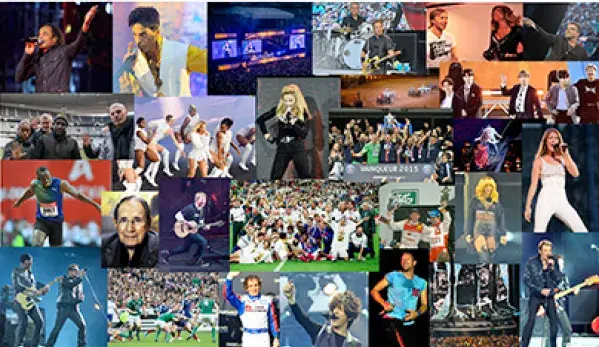OUR HISTORY
THE STADE DE FRANCE
A BRAVE GAMBLE THAT HAS BECOME THE PRIDE OF FRANCE
From its design to its construction and programming, the Stade de France has risen to the major challenges set by its founders. After 25 years in operation, it has become the stadium for all French people, the favourite stadium of the French national teams and the flag bearer of France's sporting and cultural influence.
WHY DID WE NEED A NATIONAL STADIUM?
The origins of the Stade de France lie in a major political decision taken in the late 1980s, 70 years after the construction of the Stade Yves du Manoir: a commitment by the French government to providing France with a national stadium.
This desire stemmed from an immediate need: to put France in the position to mount a successful bid to host the 1998 FIFA World Cup. Above all, however, it was the result of a long-term vision for the development of sporting and cultural events.
Without a facility of this scale, France would have gradually disappeared from the international scene, unable to meet the increasingly demanding technical requirements, the increasingly complex and diverse expectations of entertainment producers, and the rapidly growing commercial demands.
Only the government was in a position to drive such a project, supporting the professionalisation of football and rugby and the expansion of global concert tours, and to allocate the necessary resources to ensure it was served by public transport.
The Stade de France was born of this national political will and the unwavering commitment of local councillors in Saint-Denis to ensure that the Stadium would also be a vehicle for the profound transformation of their region.
The Stade de France has gradually become part of France's national heritage, thanks to a long-term partnership with major French construction companies VINCI and Bouygues. The latter have developed new skills in terms of technical, commercial and programming operations. 25 years on, the entire sports and entertainment industry has benefited from this unprecedented growth.
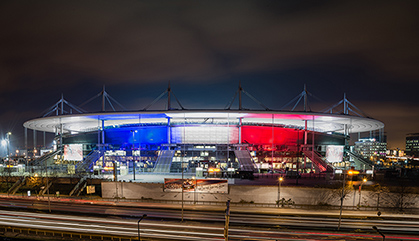
A MASSIVE PROJECT FOR A STADIUM UNLIKE ANY OTHER IN THE WORLD
The political gamble was followed by the challenge of its implementation.
The goal was to design a stadium capable of hosting everything from a football or rugby World Cup to the Olympic Games, as well as monumental productions, corporate seminars and events for the general public.
The vision was of a stadium where the French national football and rugby teams would feel at home, while at the same time providing an athletics track to host major competitions. The design needed to produce a multifunctional venue while guaranteeing audience safety. The stadium’s creators had to imagine new ways of consuming sport, future developments in the live entertainment industry and the services that would be at the heart of the economic model of the sporting federations and their stadium.
Plans for the stadium began to be drawn up digitally in 1994, and a model was then tested in a wind tunnel to withstand winds of over 145 km/h. The use of crowd simulation software also made it possible to design a stadium capable of evacuating 80,000 spectators in less than 10 minutes. It was designed to be modular enough to accommodate a wide variety of productions, and to allow for co-activity during the set-up and dismantling phases, with appropriately-sized traffic zones. It was the first stadium to be designed after the Heysel tragedy.
The design challenge was, of course, followed by the challenge of building it in time for Les Bleus' first world championship. The facility also needed to remain relevant for three decades.
Built in 31 months on a former industrial gas site, the construction of the stadium required the implementation of a system to protect the public from and capture gas emissions.
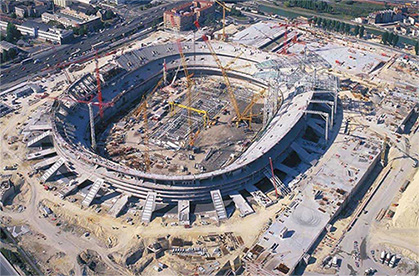
ARCHITECTURE THAT IS AS POWERFUL AS EVER
The original design by architects Macary, Zublena, Regembal and Costantini, inspired by the Pan Am Worldport at New York-JFK airport, was built by 5,000 workers and over 200 businesses.
Its elliptical roof is one of its most striking features, but also one of the most complex to build. Suspended from 18 masts 61m high and 40m apart, it floats 42 metres above the pitch, protecting the 45 km of stands, which are partially removable. Those same stands can accommodate 80,000 spectators in football and rugby configuration, 78,000 in their athletics mode and up to 100,000 for a concert with a central stage, 25,000 of which can be moved to achieve the desired configuration.
Its 18 monumental staircases leading the spectators to the upper stands are a bold architectural gesture and the Stadium’s signature.
On 26 November 2021, the Stade de France was awarded the status of "Outstanding Contemporary Architecture". It was singled out during a certification campaign focused on the Greater Paris Area as a major facility contributing to the relationship between the capital and its suburbs.
Long known as the "Grand Stade", the stadium is still the largest in France.

THE FIRST MAJOR MULTI-PURPOSE STADIUM
>> THE HOME OF LES BLEUS
The Stade de France and “Les Bleus” have grown up together.
Providing the French football and rugby teams with a stadium capable of hosting their international matches and major national finals was one of the key objectives of the concession contract awarded by the French government.
The Stade de France has gradually established itself as the "home of Les Bleus", as improvements have been made and events organised in conjunction with the French Football Associations. The fans have made the Stade de France their favourite venue. Les Bleus feel supported like never before, with the incredible competitive results to show for it.



>> AN UNPRECEDENTED LIST OF TROPHIES
In 2024, the Stade de France will be the only stadium in the world to have hosted an equivalent sporting programme >>>>>
It has also established itself as one of Europe's Top 3 concert stadiums.
STADIUMS IN 2022
in number of tickets sold
1 1,032,377 tickets - WEMBLEY STADIUM, London
2 749,863 tickets - DEUTSCHE BANK PARK, Frankfurt
3 701,613 tickets - STADE DE FRANCE, Saint-Denis
>> A RICH AND VARIED PROGRAMME
After football, rugby and concerts, e-sports have become the 4th pillar of the Stade de France. Beginning in 2018, the decision was made to become home to a resident club with VITALITY, the first French club and one of the very first in Europe. Even beyond sports and concerts, the Stade de France has developed a programme that is unprecedented in France. From operas to the most extreme sporting challenges and blockbusters such as Ben-Hur, just about everything you can imagine has happened in Saint-Denis.
There are very few people in France who can't name a significant event at the Stade de France! A look back at some of the most memorable dates...
>> A STADIUM THAT REINVENTS ITSELF
Over 25 years, the Stade has been able to transform, reinvent, innovate and surprise.
Giant nightclub, ski resort, seaside resort, racecourse...nothing is impossible for the Stade!

Since 2018, the decision has been made to host a resident esport club with VITALITY, the first French club and one of the very first in Europe.

With 545,000 injections in 6 months, it became the largest vaccination centre in the Paris region.

A massive show by Robert Hossein: a naval battle, a parade of the Roman army, gladiatorial combat, a 12-minute chariot race…

2,000 tonnes of fine sand, 500 deckchairs, 300 parasols, 4 pools and over 25 sporting activities (surfing, water skiing, sailing, scuba diving, beach football...
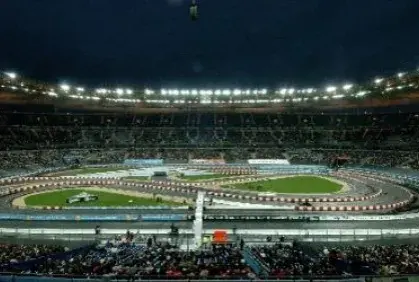
A motor racing event bringing together the world's best Formula 1, Rally and motorbike Grand Prix drivers.

A show that mixes cars, motorbikes and supercross: demos of Monster Trucks - extreme jumping competitions with the world's best freestylers...

A combination of horseracing with betting and equestrian shows: a 425-metre race track, a 10,000 m2 stage area, 4,000 m3 of earthworks, 200 tonnes of concrete...

40,000 clubbers dance to the rhythm of mixes by the biggest DJs of the moment: Carl Cox, David Guetta, Tiësto, Martin Solveig, Joachim Garraud...
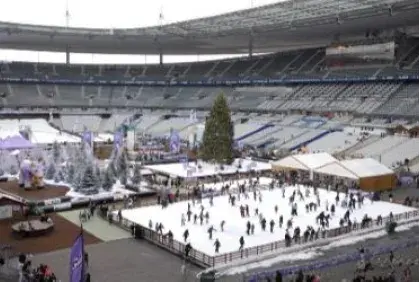
An ice rink and ice track, an adventure course, a 70-metre ski slope, climbing walls, zip lines, toboggan runs, reindeer rides, via Ferrata...
>> A NEW ERA BEGINS WITH GL EVENTS: THE STADE DE FRANCE, A STAGE FOR ALL POSSIBILITIES
In August 2025, a new chapter will begin for the Stade de France with the awarding of its concession to GL events for a period of 30 years. With its expertise in managing iconic venues and its commitment to promoting regional attractiveness, the Group intends to make the Stade de France much more than just a legendary venue: it will be a lively, innovative event destination.
Driven by an ambitious and well-thought-out vision, the project involves a gradual transformation of the site based on three main areas: enriching the programme (major sporting and cultural events, e-sports, new international formats, etc.), redesigning the spectator experience (modernised hospitality, new services, reconfiguration of spaces) and strengthening regional ties (solidarity initiatives, inclusion, consultation with regional stakeholders).
The Stade de France is thus embarking on a new chapter in its history, remaining faithful to its heritage while looking resolutely towards the future.
FRANCE'S FAVOURITE STADIUM
In a few figures:
>> The Stade de France is France's favourite stadium for sporting events.
>> 93%* of French people are familiar with the Stade de France.
>> 88%* of visitors agree that the Stade de France is part of France's heritage.
>> 80%* of visitors feel connected to the name "Stade de France".
* according to a study conducted in 2023 by Opinion Way

